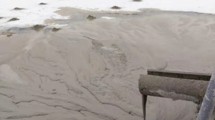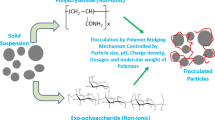Abstract
A major issue for the oil sand industry is the settling of thin fine tailings (TFT) which are a byproduct of the oil sand extraction process. These tailings are deposited in large ponds and settling takes decades. The aim of the present study was to increase understanding of the role of specific ion types (monovalent/divalent) present in the water in flocculation behavior, and hence the settling of flotation fine tailings of the Athabasca oil sands (which consist predominantly of kaolinite). In this study, two series of measurements were conducted and compared: one with TFT and with varying pH and salinity, and another with kaolinite suspensions with varying pH, salinity, and volume fraction. The volume fraction of kaolinite and TFT used was in the range 0.01–1% volume fraction for any ionic strength or ion. In this range the electrophoretic mobility was constant indicating that there were no particle-particle interactions, a required condition for electrophoretic mobility measurements. Electrokinetic measurements were made as a function of concentration of salt added and pH. The flocculation behavior of both TFT and kaolinite can be linked to the electrokinetic mobility at high ionic strength. The electrophoretic mobility values and therefore the electrokinetic charge of the particles were smaller for divalent salt than for monovalent salt. As a consequence, both kaolinite and fine tailings should and do flocculate more quickly in the presence of a divalent electrolyte during settling-column experiments. The electrophoretic mobility of kaolinite and tailings in electrolytes containing a majority of monovalent ions (NaCl) decreased in absolute values with decreasing pH while their electrophoretic mobility in electrolytes containing a majority of divalent ions (MgCl2) did not depend on pH. The flocculation of the fine tailings in an electrolyte where divalent ions are predominant is therefore not expected to be influenced by pH.
Similar content being viewed by others
References
Chassagne, C., Mietta, F., and Winterwerp, J.C. (2009) Electrokinetic study of kaolinite suspensions. Journal of Colloid and Interface Science, 336, 352–359.
Chassagne, C. and Ibanez, M. (2013) Electrophoretic mobility of latex nanospheres in electrolytes: Experimental challenges. Pure and Applied Chemistry, 85, 41–51.
Chassagne, C. and Ibanez, M. (2014) Hydrodynamic size and electrophoretic mobility of latex nanospheres in monovalent and divalent electrolytes. Colloids and Surfaces A: Physicochemical Engineering Aspects, 440, 208–216.
Clark, K.A. (1939) The hot water method for recovering bitumen from bituminous sand. Report on Sullivan Concentrator, Alberta Research Council, Edmonton, Canada.
Clark, K.A. and Pasternack, D.S. (1932) Hot water separation of bitumen from Alberta bituminous sand. Industrial & Engineering Chemistry, 24, 1410–1416.
Gupta, V. and Miller, J.D. (2010) Surface force measurements at the basal planes of ordered kaolinite particles. Journal of Colloid and Interface Science, 234, 362–371.
Gupta, V., Hampton, M.A., Stokes, J.R., Nguyen, A.V. and Miller, J.D. (2011) Particle interactions in kaolinite suspension and corresponding aggregate structures. Journal of Colloid and Interface Science, 359, 95–103.
Hunter, R.J. (2001) Foundations of Colloid Science. Oxford University Press, New York.
Hunter, R.J., Ottewill, R.H., and Rowell, R.L. (1981) Zeta Potential in Colloid Science: Principles and Applications. Elsevier, Amsterdam.
Kasperski, K.L. (1992) A review of properties and treatment of oil sands tailings. AOSTRA Journal of Research, 8, 11–53.
Kaya, A., Ören, A.H., and Yükselen, Y. (2006) Settling of kaolinite in different aqueous environment. Marine Georesources and Geotechnology, 24, 203–218.
Liu, J., Zhou, Z., Xu, Z., and Masliyah, J. (2002) Bitumen-clay interactions in aqueous media studied by zeta potential distribution measurement. Journal of Colloid and Interface Science, 252, 409–418.
Ma, K. and Pierre, A.C., (1999) Clay sediment-structure formation in aqueous kaolinite suspensions. Clays and Clay Minerals, 47, 522–526.
Ma, M. (2011) The dispersive effect of sodium silicate on kaolinite particles in process water: implications for ironore processing. Clays and Clay Minerals, 59, 233–239.
MacKinnon, M.D. (1989) Development of the tailings pond at Syncrude’s oil sands plant: 1978–1987. AOSTRA Journal of Research, 5, 109–133.
Mitchell, J.K. and Soga, K. (2005) Fundamentals of Soil Behavior (3rd edition). John Wiley & Sons, New York.
Morrison, F.A. (1970) Electrophoresis of a particle of arbitrary shape. Journal of Colloid and Interface Science, 34, 210–214.
Solomon, D.H. and Hawthorne, D.G. (1983) Chemistry of Pigments and Fillers. Wiley, New York.
Tschapek, M., Tcheichvili, L. and Wasowski, C. (1974) The point of zero charge (pzc) of kaolinite and SiO2 + Al2O3 mixtures. Clays and Clay Minerals, 10, 219–229.
Vane, L.M. and Zang, G.M.(1997) Effect of aqueous phase properties on clay particle zeta potential and electro-osmotic permeability: Implications for electro-kinetic soil remediation processes. Journal of Hazardous Materials, 55, 1–22.
Yukselen, Y. and Kaya, A. (2002) Zeta potential of kaolinite in the presence of alkali, alkaline earth and hydrolysable metal ions. Water, Air, and Soil Pollution, 145, 155–168.
Zhou, Z. and Gunter, W.D. (1992) The nature of the surface charge of kaolinite. Clay and Clay Minerals, 40, 365–368.
Zhu, R.R., Liu, Q., Xu, Z., Masliyah, J.H. and Khan, A. (2011) Role of the dissolving carbon dioxide in densification of oil sands tailings. Energy & Fuels, 25, 2049–2057.
Author information
Authors and Affiliations
Corresponding author
Rights and permissions
About this article
Cite this article
Ibanez, M., Wijdeveld, A. & Chassagne, C. The Role of Mono- and Divalent Ions in the Stability of Kaolinite Suspensions and Fine Tailings. Clays Clay Miner. 62, 374–385 (2014). https://doi.org/10.1346/CCMN.2014.0620502
Received:
Revised:
Published:
Issue Date:
DOI: https://doi.org/10.1346/CCMN.2014.0620502




